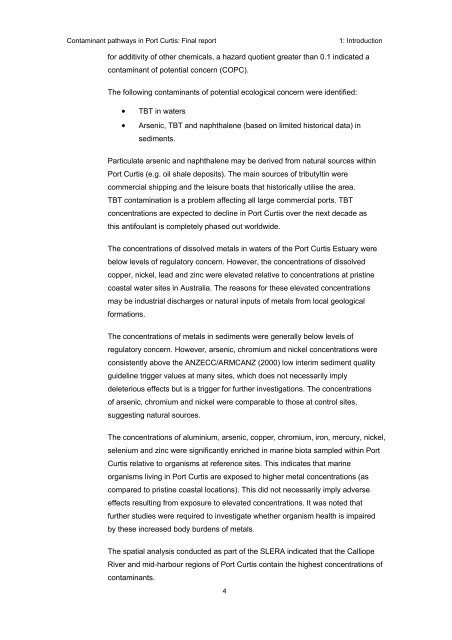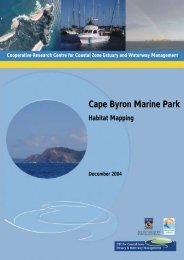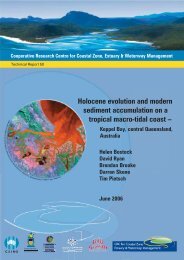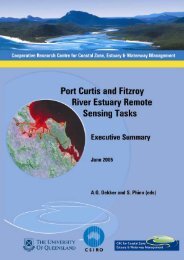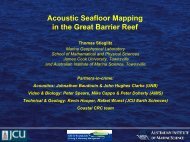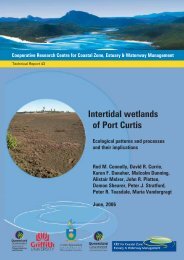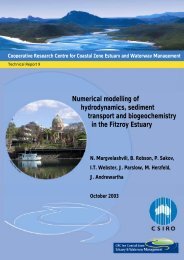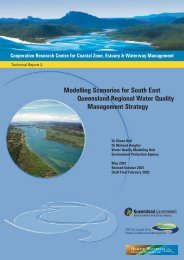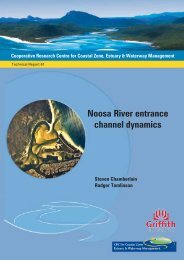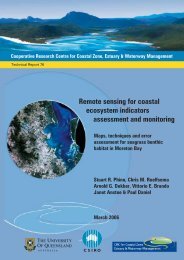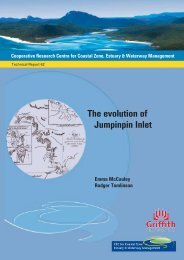Contaminant pathways in Port Curtis: Final report - OzCoasts
Contaminant pathways in Port Curtis: Final report - OzCoasts
Contaminant pathways in Port Curtis: Final report - OzCoasts
Create successful ePaper yourself
Turn your PDF publications into a flip-book with our unique Google optimized e-Paper software.
<strong>Contam<strong>in</strong>ant</strong> <strong>pathways</strong> <strong>in</strong> <strong>Port</strong> <strong>Curtis</strong>: F<strong>in</strong>al <strong>report</strong>1: Introductionfor additivity of other chemicals, a hazard quotient greater than 0.1 <strong>in</strong>dicated acontam<strong>in</strong>ant of potential concern (COPC).The follow<strong>in</strong>g contam<strong>in</strong>ants of potential ecological concern were identified:• TBT <strong>in</strong> waters• Arsenic, TBT and naphthalene (based on limited historical data) <strong>in</strong>sediments.Particulate arsenic and naphthalene may be derived from natural sources with<strong>in</strong><strong>Port</strong> <strong>Curtis</strong> (e.g. oil shale deposits). The ma<strong>in</strong> sources of tributylt<strong>in</strong> werecommercial shipp<strong>in</strong>g and the leisure boats that historically utilise the area.TBT contam<strong>in</strong>ation is a problem affect<strong>in</strong>g all large commercial ports. TBTconcentrations are expected to decl<strong>in</strong>e <strong>in</strong> <strong>Port</strong> <strong>Curtis</strong> over the next decade asthis antifoulant is completely phased out worldwide.The concentrations of dissolved metals <strong>in</strong> waters of the <strong>Port</strong> <strong>Curtis</strong> Estuary werebelow levels of regulatory concern. However, the concentrations of dissolvedcopper, nickel, lead and z<strong>in</strong>c were elevated relative to concentrations at prist<strong>in</strong>ecoastal water sites <strong>in</strong> Australia. The reasons for these elevated concentrationsmay be <strong>in</strong>dustrial discharges or natural <strong>in</strong>puts of metals from local geologicalformations.The concentrations of metals <strong>in</strong> sediments were generally below levels ofregulatory concern. However, arsenic, chromium and nickel concentrations wereconsistently above the ANZECC/ARMCANZ (2000) low <strong>in</strong>terim sediment qualityguidel<strong>in</strong>e trigger values at many sites, which does not necessarily implydeleterious effects but is a trigger for further <strong>in</strong>vestigations. The concentrationsof arsenic, chromium and nickel were comparable to those at control sites,suggest<strong>in</strong>g natural sources.The concentrations of alum<strong>in</strong>ium, arsenic, copper, chromium, iron, mercury, nickel,selenium and z<strong>in</strong>c were significantly enriched <strong>in</strong> mar<strong>in</strong>e biota sampled with<strong>in</strong> <strong>Port</strong><strong>Curtis</strong> relative to organisms at reference sites. This <strong>in</strong>dicates that mar<strong>in</strong>eorganisms liv<strong>in</strong>g <strong>in</strong> <strong>Port</strong> <strong>Curtis</strong> are exposed to higher metal concentrations (ascompared to prist<strong>in</strong>e coastal locations). This did not necessarily imply adverseeffects result<strong>in</strong>g from exposure to elevated concentrations. It was noted thatfurther studies were required to <strong>in</strong>vestigate whether organism health is impairedby these <strong>in</strong>creased body burdens of metals.The spatial analysis conducted as part of the SLERA <strong>in</strong>dicated that the CalliopeRiver and mid-harbour regions of <strong>Port</strong> <strong>Curtis</strong> conta<strong>in</strong> the highest concentrations ofcontam<strong>in</strong>ants.4


